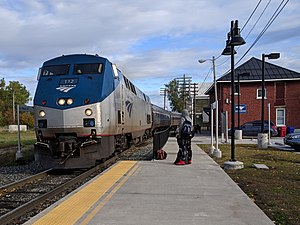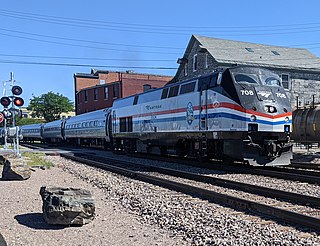
The Ethan Allen Express is a daily passenger train operated by Amtrak in the United States between New York City and Burlington, Vermont, via Albany, New York. One daily round trip is operated on a 310-mile (500 km) north–south route with a 7-hour 35 minute scheduled running time. The train is subsidized by New York and Vermont for the portion north of Albany. It is named for Vermont cofounder and American Revolutionary War hero Ethan Allen.
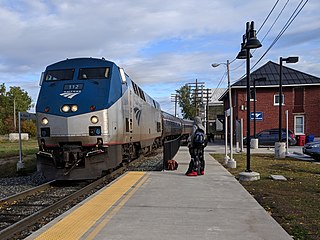
The Vermonter is a passenger train operated by Amtrak between St. Albans, Vermont, and Washington, D.C., via New York City. It replaced the overnight Montrealer, which terminated in Montreal until 1995. Amtrak receives funding from the states of Connecticut, Massachusetts, and Vermont for Vermonter operations north of New Haven.
The Vermont Valley Railroad was a 20.8-mile (33.5 km) line in Vermont and New Hampshire, running from Brattleboro to the Vermont-New Hampshire line at Windsor, now part of the Connecticut River Line. Hugh H. Henry (1814-1869) of Chester, Vermont was an original incorporator, and was chosen as its first president. He served from 1848 until his death. In New Hampshire, the line was operated as the Sullivan County Railroad. The line was eventually owned by the Connecticut River Railroad, who in turn leased the line to the Boston and Maine.

The New England Central Railroad is a regional railroad in the New England region of the United States. It began operations in 1995, as the successor of the Central Vermont Railway (CV). The company was originally a subsidiary of holding company RailTex before being purchased by RailAmerica in 2000. In 2012, the company was purchased by Genesee & Wyoming, its current owner.

Burlington Union Station is a train station and office building located in downtown Burlington, Vermont, United States. It is the northern terminal of the Amtrak Ethan Allen Express service. A single side platform on the west side of the station serves Vermont Railway excursion trains and Amtrak trains. The symmetrical Beaux Arts building, built of buff brick with limestone and granite trim, has a central pilaster over two entrances. The main building is divided for use by a variety of tenants.
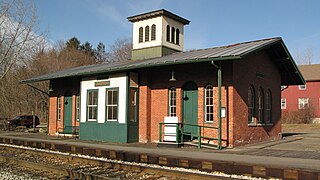
Amherst is a former intercity rail station located in Amherst, Massachusetts. The station was built by the Amherst and Belchertown Railroad in 1853; it was served by the Central Vermont Railway until 1947. Amtrak service began in 1989 with the Montrealer; it was replaced by the Vermonter in 1995. The station was closed on December 28, 2014, when the Vermonter was rerouted to the faster Connecticut River Line to the west.

Union Station is an Amtrak intercity rail station located in downtown Brattleboro, Vermont, United States. It is served by the one daily round trip of the Vermonter service. Most of the 1915-built station is occupied by the 1972-opened Brattleboro Museum and Art Center, while Amtrak uses a waiting room on the lower floor. The building was added to the National Register of Historic Places in 1974.

Bellows Falls station is an Amtrak intercity rail station located in the Bellows Falls village of Rockingham, Vermont, United States. The station is served by the single daily round trip of the Washington, D.C.–St. Albans Vermonter. It has a single side platform adjacent to the single track of the New England Central Railroad mainline.

White River Junction station is a passenger train station in White River Junction, Vermont, served by Amtrak's Vermonter. It is also used by the Green Mountain Railroad for passenger excursion trains to Thetford and the Montshire Museum of Science in Norwich, Vermont. Originally, it was built in 1937 as a union station that served the Boston and Maine Railroad and Central Vermont Railway. On display adjacent to the station is a sheltered display of Boston and Maine Railroad #494, a historic steam locomotive. The station's historic building is a contributing property in the White River Junction Historic District, which is listed on the National Register of Historic Places. Dartmouth College is five miles to the north in Hanover, New Hampshire.

Randolph station is an Amtrak train station in Randolph, Vermont, United States. The only train that serves the station is the Vermonter, which operates between St. Albans, Vermont and Washington, D.C. The former depot building contains a market and restaurant. On the other side of the tracks is the depot for a non-profit bus company, Tri-Valley Transit, essentially creating an unofficial intermodal transportation center. However, the schedules of the two systems are not aligned in any way.

Montpelier station, also known as Montpelier–Berlin station and Montpelier Junction, is a railroad station in Berlin, Vermont, United States. It is served by Amtrak's Vermonter line and provides service to the nearby cities of Montpelier and Barre.

Essex Junction station, also known as Essex Junction–Burlington, is an Amtrak train station in the city of Essex Junction, Vermont, United States. The station was originally built by the Central Vermont Railway in 1959. It serves Amtrak's Vermonter train, which runs from St. Albans, near the Canada–U.S. border, south to Washington, D.C. Prior to bridge trouble at Alburg, north of St. Albans, train service continued to Montreal. Until the early 1960s, the Boston and Maine railroad operated Montreal to Boston service on The Ambassador through the station.

Union Station is a historic former railroad station located in downtown Palmer, Massachusetts. The building, which was designed by American architect H. H. Richardson, opened in June 1884 to consolidate two separate stations nearby. The grounds of the station were originally designed by Frederick Law Olmsted.

The Central Corridor Rail Line was a proposed passenger service route between New London, Connecticut, and Brattleboro, Vermont. A primary purpose of the proposed service was to provide a rail link between state flagship schools UConn, UMass Amherst, and UVM.

The John W. Olver Transit Center, also called the JWO Transit Center, is an intermodal transit hub for Franklin County, Massachusetts. Located in Greenfield, it currently serves Franklin Regional Transit Authority (FRTA) local bus routes plus intercity bus service. Amtrak's Greenfield station is also located here, with one daily Vermonter round trip and two daily Valley Flyer round trips, which are extensions of Amtrak-run Hartford Line trains.
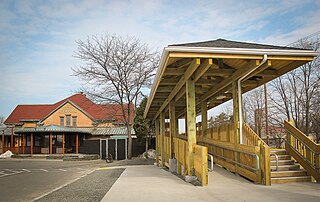
Union Station is a historic building in Northampton, Massachusetts, that served as a train station from 1897 until 1987. Built at the close of the nineteenth century, the structure incorporates many features of the Richardsonian Romanesque architectural style. The buff brick masses of the station are trimmed with red Longmeadow brownstone and hooded by red tile roofs. Steep dormers protrude from the roofline. The interior once featured Italian marble floors, oak woodwork, and a large fireplace.

The Montrealer was an overnight passenger train between Washington, D.C., United States, and Montreal, Quebec, Canada. The train was operated from 1924 to 1966, and again under Amtrak from 1972 to 1995, excepting two years in the 1980s. The train was discontinued in 1995 and replaced by the Vermonter, which provides daytime service as far north as St. Albans, Vermont. Current Amtrak service to Montreal is provided by the daytime Adirondack from New York City via Albany.

Holyoke station is an Amtrak intercity train station near the corner of Main and Dwight streets in Holyoke, Massachusetts, United States. The station opened on August 27, 2015, eight months after Amtrak's Vermonter service was re-routed to the Connecticut River Line through the Pioneer Valley.
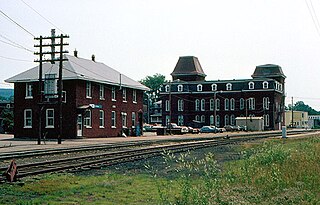
The Central Vermont Railroad Headquarters is a complex of railroad-related buildings and infrastructure in the city of St. Albans, Vermont. Developed between the 1860s and 1920s by the Central Vermont Railroad (CVR), the complex is the largest assemblage of railroad-related buildings in Vermont. Located between Catherine and Pine Streets on either side of Lake Street, it was listed on the National Register of Historic Places in 1974. Many of the buildings are no longer used for railroad functions, but the former Central Vermont Railway Office now houses the offices of the New England Central Railroad, and the present Amtrak station uses a former CVR building.
